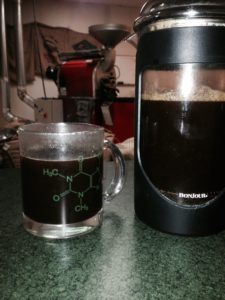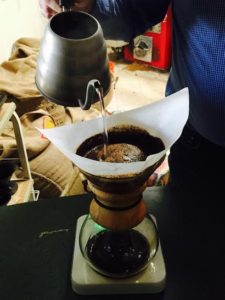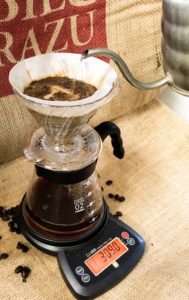It’s All About the Brew
Brewing the Best Cup of Coffee Possible at Home
For painters, all quality paints have the potential to create artistic masterpieces. It’s about how you use them to create the artistry. For coffee-lovers, their palette of beans can positively or negatively impact their tasting palate, depending on how they brew them. Because once the coffee is selected, it’s all about the brew.
We’ll discuss variations in coffee varietals, blends and regions in an upcoming blog. Here, we’ll talk about how to brew the coffee you currently love, for instance anything from Wood-Fire Roasted, into the best cup it can possibly be.
Flavorful Science Stuff
First, make sure you start with a bag of whole-bean Arabica coffee. When roasted, CO2 gets trapped within the millions of cells found in a coffee bean and expands them. Also found within these cells post-roast are soluble compounds that are aching to break free and flavor your cup of joe.
Only about 30% of each bean is made of soluble compounds — and only about 20% of those are tasty — while the other 70% is made from insoluble elements like cellulose and other fibers that help make up the bean’s structure.
Our mission, an entirely possible one, during the brewing process is to extract the tasty notes from the 20% and leave behind the bitter ones in the other 10%.
When dissolved by adding properly heated water to properly ground beans, fruit acids and caffeine are the easiest compounds to release and create the lighter, fruitier notes found in brewed coffee.
Lipids, which aren’t technically water-soluble but do emulsify into a cup when heated H2O is added, provide the nutty and chocolatey notes and that “oil slick” component on top; the fibers and carbohydrates are the toughest compounds to release from the beans, and add sweeter, earthier elements to a coffee cup.
Finding & Grinding
Whatever your roast and taste preference, make sure the beans you purchase were roasted within three weeks. That’s about the shelf-life of roasted beans before they start losing their volatile flavor profiles. Volatile flavor profiles are a bit moody, but they’re also those that we love in our cup, like spicy, floral and fruity notes. The static flavor profiles that are more resilient are the bitter 10% we made mention of above. No one wants those hanging around once the good ones start disappearing.
Pre-ground beans take far less time. Roasters who truly care how their coffee tastes when brewed will have a “Roasted On” date clearly listed on their bags.
Then, let your brewing method — discussed in the next section — dictate your grind. Best for control is a hand-crank grinder, but Burr grinders work well also. Blade grinders unfortunately create too many flavor-affecting inconsistencies and the friction created can scorch beans.
Grind is so important because the more water that comes into contact with a coffee bean’s cells, the more it extracts from them. Solubles carrying the less enticing flavor characteristics are thankfully the toughest to extract, so controlling the time water comes in contact with the bean cells makes it easier to control the resulting taste.
This can be done by breaking the bean down into smaller parts by grinding into fine, medium or coarsely ground coffee. The finer the grind, the less time it takes for water to extract the same solubles from the cells of the beans.
This great article on HandGround.com entitled An Intuitive Guide to Coffee Solubles, Extraction and TDS explains:
“Grind size doesn’t determine what is being extracted, it determines how long it will take for the water to reach all of the cells. Hopefully it is starting to become clear how time and grind size are inversely linked. When we increase one, we must decrease the other.”
For instance, using a consistent water temperature, the same number of compounds can be extracted from a fine grind in 30 seconds as can be extracted from a medium grind in 120 seconds, or a coarse grind in 240 seconds.
HandGround.com’s article elaborates:
“The solubles released during extraction determine the flavor and Total Dissolved Solids (TDS) determines the intensity of those flavors. This is similar to music if you think of solubles as the music itself and TDS is how loud the volume is set. Increasing TDS will produce a stronger flavor but turning it up too high may cause some flavors to overpower others completely.”
Now is when the method comes into play.
Just Add Water

Before we get to brewing, a note on the importance of water temperature…it’s super important.
Only ten degrees separate mediocre from perfection. Whatever your brewing method of choice, the water needs to be between 195° and 205° Fahrenheit. Anything below may not extract the best flavor compounds, anything higher may scorch them, leaving you with a burned taste in your cup.
Usually this temperature can be acquired just before your water gets to a rolling boil. At high elevations, water conveniently boils at around the correct temperature for brewing coffee, like here in Reno, around 203.8°. But use a thermometer to be absolutely sure.
If using a device requiring a paper filter, it’s best to rinse the filter first with a bit of Brew temperature water before using to eliminate any impurities within it that may affect coffee taste. Let the rinse water drip through into a cup and discard.
Then, soak your grounds first in situ, meaning wherever they rest before brewing, such as in a French press or paper filter, add a bit of water to them to help them “bloom”. This pre-infusion process helps to release any residual CO2 left in the beans after roasting that can block water from getting to the flavor-filled solubles.
Agitate the grounds to ensure all the CO2 is released; once the bubbling action you’ll see stops, you’re good to brew.
Optimal extraction level from within the beans is about 20%, meaning 20% of the mass of the coffee beans ends up in our cup after being dissolved by water. If your coffee is bitter, solubles may be over-extracted and you may need to make the grind coarser and lessen the brew time. If it’s sour and lacking in sweetness, you may be under-extracting the solubles and need to increase the brew time using a finer grind.
Contraption Savvy
There are nearly infinite amounts of contraptions available to brew coffee these days. From the Keurig to the Chemex, even a new device called the Aeropress, your options are endless — unless you seek brewing perfection.
Around WFRC, you won’t find a drip coffeemaker, (unless we’re using it for comparison’s sake.) Drip coffeemakers take so long to pump out a single pot of coffee, letting the beans lounge in whatever-temperature water, that it extracts every last flavor profile from the bean, including the ones we don’t want.
Instead, around the roastery you will find a French Press, an espresso machine, and pour-over systems including a Chemex(tm).

No matter the system, the ratio of ground coffee to water must be delicately balanced. Owner of Wood-Fire Roasted Coffee Tim Curry feels the ideal ratio is 15:1, meaning one part coffee to 15 parts water. Two tablespoons of ground coffee to six ounces of water is just about 15:1.
Increasing the ratio of coffee to water will make the brew bolder, decreasing will lighten the flavors significantly. Too much adjustment will either leave the wonderful flavor components behind if too much coffee is used, or extract too much of the less desirable components, leaving the coffee both weak and bitter.
Pour-over systems like the Chemex, or one of the BPA-free plastic models, use a paper filter to help prevent bitterness by capturing the lipids that cause it. Only 1/10th of lipids in a bean can get through the paper filters, so the resulting taste and mouthfeel tends to be crisper.

A French Press eliminates the need for a paper filter, exchanging it for a built-in metal mesh filter. This allows lipids to pass through into your cup creating a creamier and more viscous mouthfeel.
French press users simply add the desired ratio of grounds to the device, then let them bloom before filling the press with the appropriate ratio of water. Allow to sit for four minutes before pressing the plunger and pouring brewed liquid perfection.
In your pursuit of coffee perfection, pack up that ol’ standby countertop coffee maker and pick either a French press or a pour-over system. Then follow these steps to make each day a bit more flavorful.
Steps for the Perfect Brew:
1) Pick your brewing system.
2) Heat the water to 195°-205°.
3) Grind the beans appropriately.
4) Measure the grounds to create the 1:15 ratio of grounds to water.
5) Bloom the grounds for approximately 30 seconds.
6) Continue pouring perfectly heated water over the beans, six ounces of water to two tablespoons of grounds is
ideal. With a scale this would be 20 grams of ground coffee and 300 grams (12 ounces) of water.
7) Let the fantastic flavors drip into your cup for approximately three-four minutes. Plunge if using a French
press. Discard filter and remove contraption if pour-over.
8) Enjoy!
9) For fun, take a selfie of yourself enjoying your first sips and tag @woodfireroasted on Twitter, Facebook or
Instagram.


